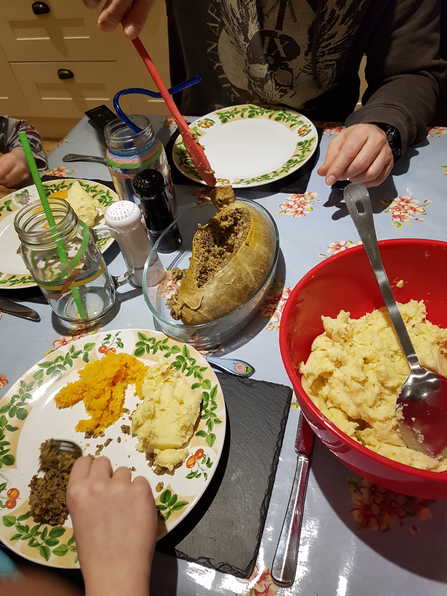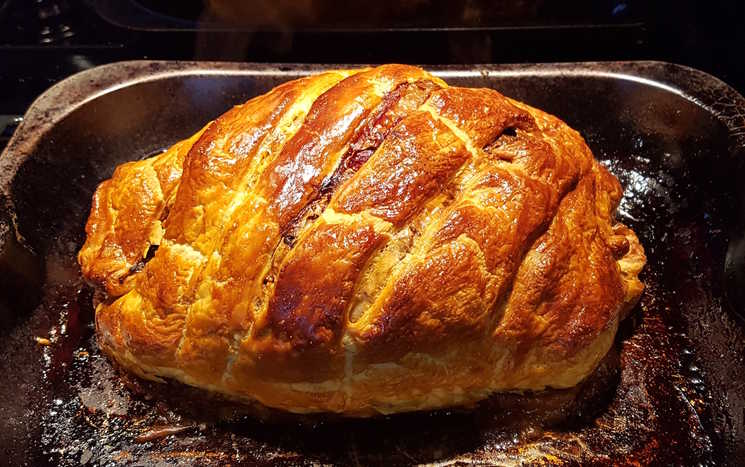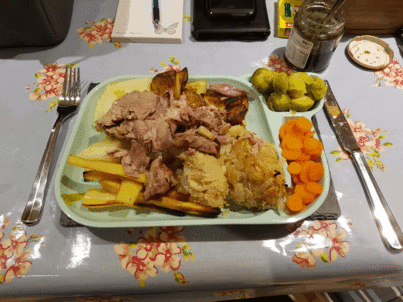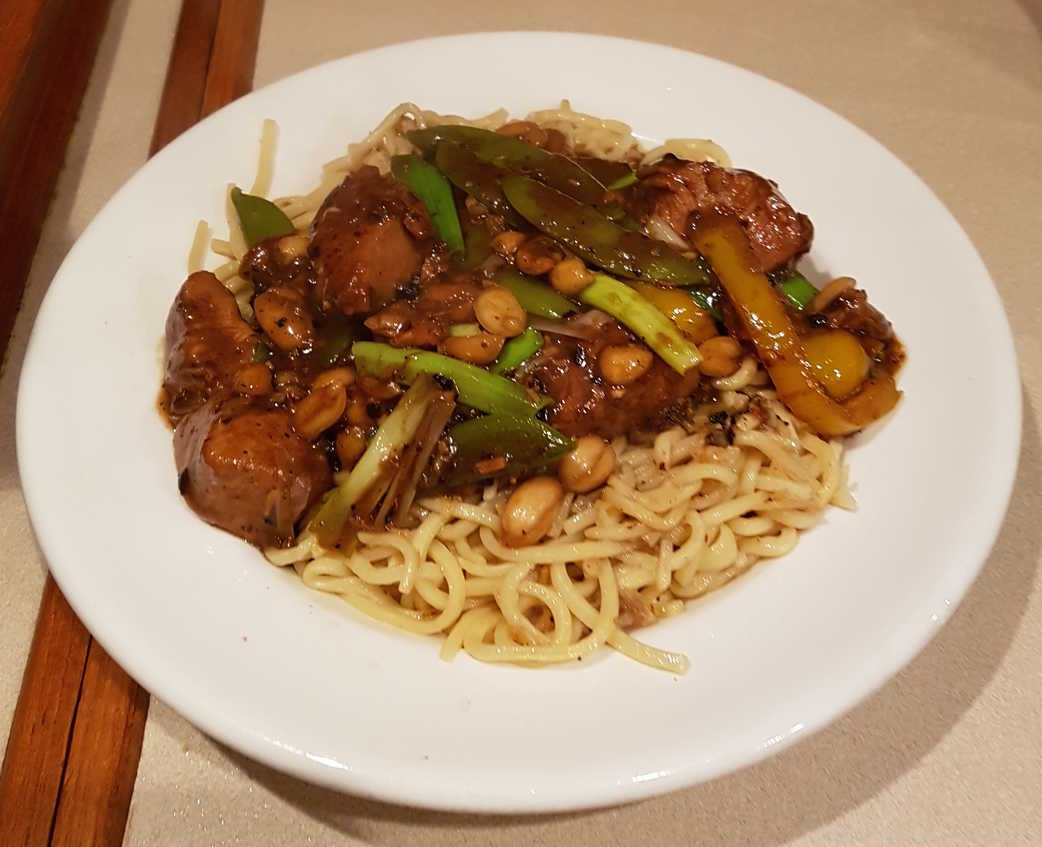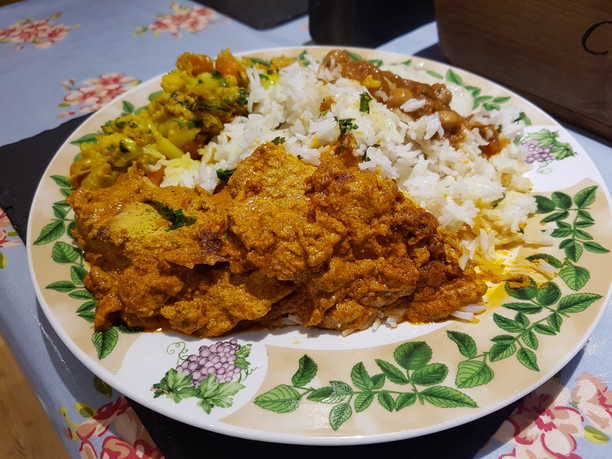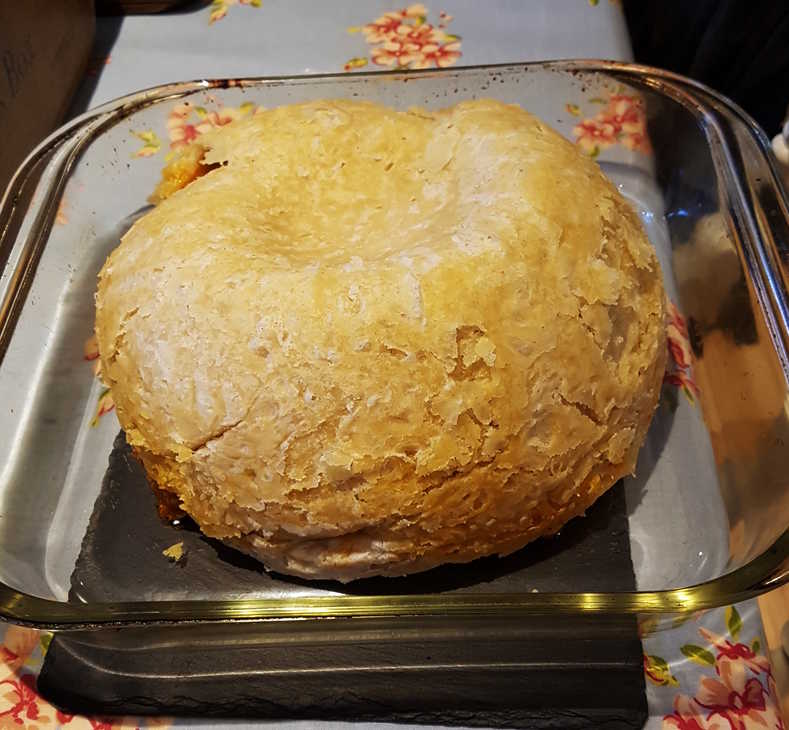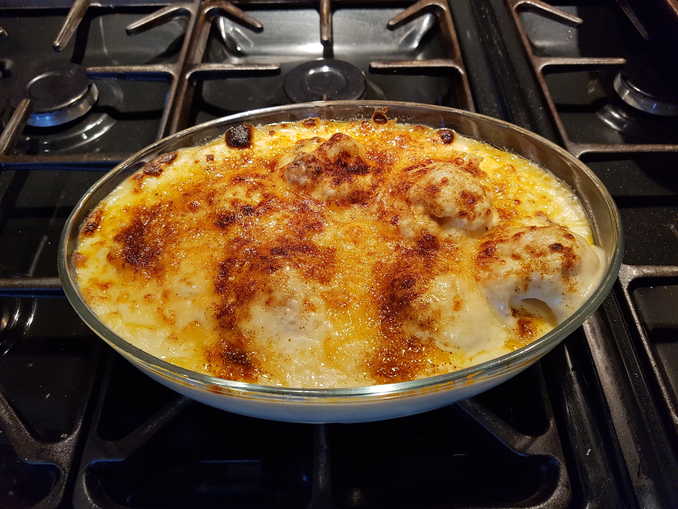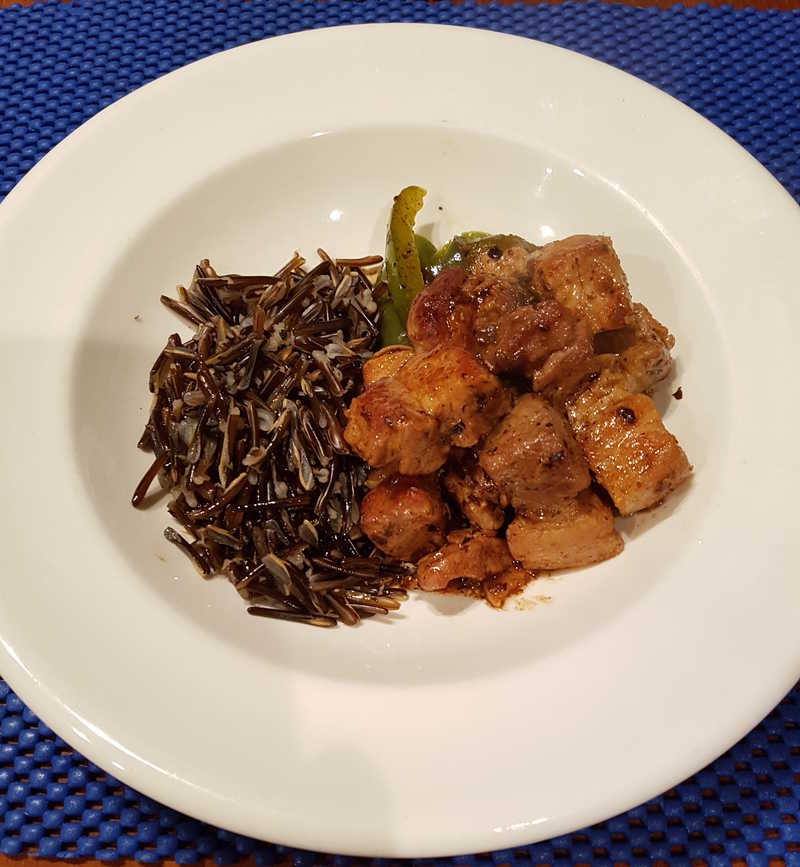
Cooking With Kurt

Since Christmas I've been living at my brother's place waiting for the bit of snow to melt (who really enjoys having me around and doesn't find it a burden in any way at all) and so I've been doing a lot of cooking for him, and we've even done some cooking together.
I made a surprisingly decent giant Beef Wellington out of an old boot a Local Fucking Supermarket™ rolled roasting joint.
Kurt introduced me to a surprisingly easy way of cooking an oriental-style chicken, probably because he was sick to death of my black bean sauce. During the continuing assault on my onboard bean collection before Christmas I attacked my bag of salted beans and turned out a giant batch of black bean sauce (a few salted beans go a long way). I brought it with me from the boat when I moved in and we've been eating it in various ways ever since :)
Due to our determination to have a very bloody mary Christmas we've also had a gallon of tomato juice to use up. I've bent some of the inevitable slew of post-Christmas curries I've been cooking, like this chicken makhani, to that end, as well as a rather tasty, if massive, traditional suet pudding.
Becky gave me a lovely whale plate for Christmas - it's not as big as a whale, but it's got a big smiley whale face and great edges for keeping food aboard during tossy storms. Kurt filled it for me with roast lamb, Mum's suet pudding and all the roast trimmings.
I used up the last of my frozen Haggii (2015 vintage) on a Burns Supper for Diane and Steve - some local English types.
Steve and I made a concerted effort to clear out my old whiskies in honour of the bard. Kurt's kids were surprisingly happy eating the haggis itself (it probably helped that we told them it was just made of minced lamb), bravely attempted the neeps (mashed with some fried ginger, cointreau and some carrots) but bizarrely baulked at the tatties!
Baked tatties mashed with roast garlic, cream and butter. What's not to like?
Weirdos!
Black Bean Sauce
oriental veg vegan sauce
As far as I can tell, the black beans labelled salted I used
are the same thing as fermented black (soy) beans.
Or douchi in Chinese.
I basically followed the Daring Gourmet except I bumped up the bean quantity. Since I take my black bean sauce strong :)
I basically followed the Daring Gourmet except I bumped up the bean quantity. Since I take my black bean sauce strong :)
Makes about 2 cups
Ingredients
- 9 tablespoons fermented black beans, soaked in water about an hour then rinsed and drained
- 4 tablespoons oil
- 4 tablespoons finely minced garlic
- 4 tablespoons finely minced ginger
- 6 green onions, thinly sliced
- 1 cup vegetable or chicken broth
- lemon or orange zest optional
- 4 tablespoons Chinese rice wine or dry sherry
- 2 tablespoon soy sauce
- 2 teaspoon sugar
- 1 teaspoon rice vinegar
- 1 or 2 teaspoon hot red pepper sauce or sambal oelek, for heat (optional)
- 3 teaspoons cornstarch dissolved in 1 tablespoon water
Mash soaked and drained fermented black beans with a fork and set aside.
Heat the oil in a small saucepan over medium-high heat. Add the minced (or grated) ginger and cook for 1-2 minutes until softened and fragrant. Add the minced (or crushed) garlic and cook for 1-2 minutes until softened and fragrant. Add the green onions and cook for another minute or two. Add the mashed beans and cook for another minute or two.
Add all remaining ingredients, except for the cornstarch mixture, and bring to a boil. Add some citrus fruit peel too if you want a zesty edge. Reduce the heat to medium and simmer uncovered for 10-15 minutes or until the liquid is reduced by half and the sauce becomes thick and gloopy. Stir in the cornstarch mixture and simmer for another minute or until thickened.
Let the black bean sauce cool and store in an airtight container (preferably glass). Will keep for up to 2 weeks.
Heat the oil in a small saucepan over medium-high heat. Add the minced (or grated) ginger and cook for 1-2 minutes until softened and fragrant. Add the minced (or crushed) garlic and cook for 1-2 minutes until softened and fragrant. Add the green onions and cook for another minute or two. Add the mashed beans and cook for another minute or two.
Add all remaining ingredients, except for the cornstarch mixture, and bring to a boil. Add some citrus fruit peel too if you want a zesty edge. Reduce the heat to medium and simmer uncovered for 10-15 minutes or until the liquid is reduced by half and the sauce becomes thick and gloopy. Stir in the cornstarch mixture and simmer for another minute or until thickened.
Let the black bean sauce cool and store in an airtight container (preferably glass). Will keep for up to 2 weeks.
Tasty stuff.
Belly Pork in Black Bean Sauce
meat main oriental stew
It's more usual to use spare ribs in a dish like this, but I accidentally bought belly pork instead, so decided to run with it.
I'm glad I did - it's delicious and you don't have to be constantly picking out the bones.
The extras are a bit random, you can more-or-less throw in whatever you have handy.
The extras are a bit random, you can more-or-less throw in whatever you have handy.
Serves 2-3
Ingredients
- peanut oil for frying
- 0.5 kg belly pork, cut into 1½" cubes
- a few garlic cloves, sliced thickly
- 1" root ginger, minced optional
- 1 small onion, chopped optional
- 1 carrot, peeled, bias sliced optional
- 1 cooked potato, chopped optional
- 1 green pepper, cored, sliced
- 3-4 tablespoons black bean sauce
- a little stock or water or rice wine
- a few spring onions, sliced, marinated in rice wine for garnish
- a dash of sesame oil
Cover the bottom of a wok or large frying pan with groundnut oil and heat until shimmering.
Add the belly pork cut into approximately 1½" cubes and fry, turning occasionally until lightly browned. Set aside.
Reheat the wok and fry the ginger until lightly coloured if using, add the carrot if using, add the onion if using, add the garlic, add the pepper and fry a little. Return the belly pork to the wok, add the black bean sauce and a little stock, water or rice wine for lubrication if necessary. Add the chopped cooked potatoes if using. Cover and simmer on low heat for 10 minutes. Uncover to thicken the sauce if necessary. Before serving cover with sliced spring onions which have been soaking in rice wine, then dress with a drizzle of sesame oil
Add the belly pork cut into approximately 1½" cubes and fry, turning occasionally until lightly browned. Set aside.
Reheat the wok and fry the ginger until lightly coloured if using, add the carrot if using, add the onion if using, add the garlic, add the pepper and fry a little. Return the belly pork to the wok, add the black bean sauce and a little stock, water or rice wine for lubrication if necessary. Add the chopped cooked potatoes if using. Cover and simmer on low heat for 10 minutes. Uncover to thicken the sauce if necessary. Before serving cover with sliced spring onions which have been soaking in rice wine, then dress with a drizzle of sesame oil
Excellent stuff. Serve with rice or some similarly absorbent carbohydrate.
Kung Pao Chicken
main fowl oriental
A classic Sichuan dish that should really use Sichuan peppercorns,
though if you can't find any then ordinary mixed coloured peppercorns make a surprisingly decent substitute.
Serves 4
Ingredients
- 1-2 pound skinless, boneless chicken breast or thighs, cut into 1-2" cubes
- 2 tablespoons peanut oil
- 2 tablespoons whole Sichuan peppercorns or mixed peppercorns, lightly crushed
- 12 dried red chillies (or fewer depending on heat preference)
- 6 cloves garlic, minced
- 2" fresh ginger, minced
- ½ - 1 cup unsalted dry-roasted peanuts
- 6 spring onions, sliced, the green and white parts kept separate
Marinade:- 1 tablespoon soy sauce
- 2 teaspoons Chinese rice wine or dry sherry
- ½ teaspoon cornstarch
Sauce:- 2 tablespoons Chinese black vinegar, or substitute 1 tablespoon quality balsamic vinegar and 1 tablespoon rice vinegar
- 1 tablespoon soy sauce
- 1 tablespoons hoisin sauce or make your own or use Oyster sauce, like I did :)
- 2 tablespoon sesame oil
- 2 tablespoons sugar or palm sugar
- 2 teaspoons cornstarch
- 2-4 tablespoons black bean sauce I like mine black beany
In a medium bowl, stir together the soy sauce, rice wine, and cornstarch until the cornstarch is dissolved.
Add the chicken and toss to coat and let it marinate for at least 10 minutes.
In a small bowl, combine the vinegar(s), soy sauce, hoisin sauce, sesame oil, sugar, and cornstarch. Stir until the sugar and cornstarch are dissolved. Set aside.
Heat a wok or large skillet over high heat until a drop of water sizzles when thrown in. Add the oil and coat the bottom of the pan. Add the Sichuan peppercorns and stir-fry for about 30 seconds until they spit and release their flavour mixed peppercorns (red, green, white, black and some allspice) aren't too bad a substitute for Sichuan peppercorns - lightly crush them with a pestle and mortar first then add the chillies and fry until they begin to darken.
Shake off the marinated chicken pieces and stir-fry them, adding them gradually so as not to overload the pan. Fry until no longer pink.
Add the minced ginger and garlic and stir-fry. Add the white parts of the green onion and fry.
Transfer to a dish, sprinkle the green parts of the green onions on top, and serve immediately with rice.
In a small bowl, combine the vinegar(s), soy sauce, hoisin sauce, sesame oil, sugar, and cornstarch. Stir until the sugar and cornstarch are dissolved. Set aside.
Heat a wok or large skillet over high heat until a drop of water sizzles when thrown in. Add the oil and coat the bottom of the pan. Add the Sichuan peppercorns and stir-fry for about 30 seconds until they spit and release their flavour mixed peppercorns (red, green, white, black and some allspice) aren't too bad a substitute for Sichuan peppercorns - lightly crush them with a pestle and mortar first then add the chillies and fry until they begin to darken.
Shake off the marinated chicken pieces and stir-fry them, adding them gradually so as not to overload the pan. Fry until no longer pink.
Add the minced ginger and garlic and stir-fry. Add the white parts of the green onion and fry.
If you fancy adding extras, like sugarsnap peas and sliced red/yellow peppers, as I did, then decant the fried chicken into another pot,
then fry each extra ingredient separately and add to the pot.
Mix together the leftover marinade, the sauce ingredients, the black bean sauce and a little water (perhaps from rinsing out the frying pan).
Pour over the chicken, stir to coat, add the unsalted peanuts I just rinsed the salt off some salted peanuts,
stir, cover and cook for a few minutes. Keep stirring occasionally as the sauce will stick.Transfer to a dish, sprinkle the green parts of the green onions on top, and serve immediately with rice.
Very good - even without the Sichuan peppers!
I had mine with fresh Chinese egg noodles rather than rice. Just to be contrary. I fried the noodles over high heat in a puddle of oil in the rinsed-out frying pan. I didn't worry about the noodles sticking and burning (a bit), just added barely enough water to loosen them at the end, steamed that off, then scraped them out. They came out pretty cleanly.
I had mine with fresh Chinese egg noodles rather than rice. Just to be contrary. I fried the noodles over high heat in a puddle of oil in the rinsed-out frying pan. I didn't worry about the noodles sticking and burning (a bit), just added barely enough water to loosen them at the end, steamed that off, then scraped them out. They came out pretty cleanly.
Easy Sticky Chicken
fowl main
My brother introduced me to this really easy
Slimming World recipe that really takes only minutes to prepare and 20 to cook.
Jamie Oliver eat your heart out.
Unless you want to have something with it of course.
Serves 4
Ingredients
- 3 tbsp honey
- 3 tbsp balsamic vinegar
- 3 tbsp soy sauce/tamari
- 680g chicken breasts, cut into 1" cubes
Mix together the honey, vinegar and soy sauce.
Toss the chicken cubes in the mix to coat thoroughly, and leave to stand for at least 30 minutes in the fridge.
Heat a frying pan, add the chicken cubes and marinade. Cook on a high heat for about 20 minutes, until all the liquid has absorbed into the chicken. Stir regularly to prevent burning.
When the chicken is thoroughly cooked, serve immediately on a bed of crispy salad or perhaps some rice?.
Heat a frying pan, add the chicken cubes and marinade. Cook on a high heat for about 20 minutes, until all the liquid has absorbed into the chicken. Stir regularly to prevent burning.
When the chicken is thoroughly cooked, serve immediately on a bed of crispy salad or perhaps some rice?.
Surprisingly good. And it could hardly be easier.
Easy Peasy Chicken Makheani Makhani
curry main fowl
Also known as butter chicken.
This is a simplified form of a variety of various chicken makhani recipes (some better than others) that seems to work just as well.
You can pretty much use whatever spices you like in the marinade or in the sauce - add chilli powder if you don't want to add fresh chillies to the ground onion/ginger/garlic paste, add red food colouring if you want bright pink chicken. (Yum!)
If you wanted to kick it up a notch you could make the sauce using ground onion/garlic/ginger paste like (or instead of) the marinade. If you're lucky you might still get the sauce cooked in the time it takes to roast the chicken pieces.
This is a simplified form of a variety of various chicken makhani recipes (some better than others) that seems to work just as well.
You can pretty much use whatever spices you like in the marinade or in the sauce - add chilli powder if you don't want to add fresh chillies to the ground onion/ginger/garlic paste, add red food colouring if you want bright pink chicken. (Yum!)
If you wanted to kick it up a notch you could make the sauce using ground onion/garlic/ginger paste like (or instead of) the marinade. If you're lucky you might still get the sauce cooked in the time it takes to roast the chicken pieces.
Serves 4-6
Ingredients
- 2 chickens
- ghee/oil for frying
For the Marinade:- one onion
- 1-2 golfballs of ginger
- half a head of garlic
- juice of 1 lime
- half a dozen green chillies, de-seeded
- 300ml yoghurt
- 1 teaspoon turmeric
- 1 teaspoon paprika
- 1 teaspoon ground cumin
- 1 teaspoon ground coriander
- 1 teaspoon garam masala
- ½ teaspoon salt
- ½ teaspoon red food colouring or beetroot powder
For the Makhani Sauce:- 1 teaspoon chilli powder
- 1 teaspoon cumin powder
- 2 teaspoons coriander powder
- 1 teaspoon garam masala
- 1 teaspoon turmeric
- about 500ml tomato juice/puréed canned tomatoes/puréed skinned, de-seeded fresh tomatoes
- about 100g butter, cubed, chilled
- ground, dried fenugreek leaves (methi) optional
- a little vinegar optional
- about 100ml cream
Joint, skin and debone the chicken or leave as larger pieces on the bone - your choice
and cut the flesh into large-ish chunks (or chop up the equivalent pre-prepared chicken breasts or thighs).
Peel, roughly chop, then blend the onion, ginger, garlic, chillies, and lime juice to a paste. Add a little of the yoghurt if necessary for lubrication.
Stir in the ground spices and the rest of the yoghurt. Mix in the chicken pieces with a fork - piercing them a little to make sure the marinade will penetrate.
Leave for 24 hours or so if you can.
Pre-heat the oven to Gas Mark 6-7.
Pick the chicken pieces out of the marinade shaking off any excess and and lay them out on a rack over an oven tray with a little (2-3 tbsps) water in it (to stop the runoff from burning). Roast for about 30 minutes until they begin to brown a little. Add a little more water to the tray underneath if the juices begin to stick or burn
Set aside.
Mix with the cooked chicken pieces and serve.
Pre-heat the oven to Gas Mark 6-7.
Pick the chicken pieces out of the marinade shaking off any excess and and lay them out on a rack over an oven tray with a little (2-3 tbsps) water in it (to stop the runoff from burning). Roast for about 30 minutes until they begin to brown a little. Add a little more water to the tray underneath if the juices begin to stick or burn
Set aside.
If you preferred you could just simmer up the chicken pieces in the marinade instead of roasting, though I think you'd lose some flavour.
Meanwhile mix the ground spices for the sauce with a little water to make a paste.
In a large, deep frying pan or wok cook the paste in a generous amount of oil/ghee until the oil begins to separate and any harsh aroma has cooked off.
Add the leftover marinade and cook down until thickened and the oil begins to separate.
Add the crushed tomatoes or tomato juice and cook until thickened and any raw flavour has cooked off
(this will take quite a long time with fresh tomatoes).
Add any juices in the oven tray from cooking the chicken
Gradually whisk in the chilled butter and cook for a minute. Add a few drops of vinegar if the sauce isn't quite sour enough.
Add some finely crushed (use a pestle and mortar) dried methi leaves if using
you can add these earlier to the frying marinade if you prefer which means they don't need to be so finely ground
and then stir in the cream.Mix with the cooked chicken pieces and serve.
Very tasty. I'm not even sure it was distinguishable from the more complex versions
(well, except for being better than Camellia Panjabi's,
but then which isn't?).
I added tomato juice and cream until the sauce looked and tasted right, so those quantities are approximate.
I added tomato juice and cream until the sauce looked and tasted right, so those quantities are approximate.
It's also a perfectly good curry if you miss out the cream entirely.
Steak, Tomato and Balsamic Suet Pudding
meat main
I have a lot of tomato juice to consume, leftovers from a bloody mary indulgent Christmas.
So that's what I used.
You could use tinned tomatoes or a lot of fresh tomatoes, but to be honest then I'd probably prefer to use the more traditional stout or ale.
Probably a few mushrooms, or a bit of bacon wouldn't go amiss either.
So that's what I used.
You could use tinned tomatoes or a lot of fresh tomatoes, but to be honest then I'd probably prefer to use the more traditional stout or ale.
Probably a few mushrooms, or a bit of bacon wouldn't go amiss either.
Serves 4
Ingredients
- 700g braising steak, cubed
- oil for frying
- 3 leeks, sliced into fat rounds
- 3 carrots, peeled, sliced into fat rounds
- 6 garlic cloves, peeled, halved if large
- 2 bay leaves
- herbs, chopped
- glass white wine
- 2 tblsps balsamic vinegar
- 1 pint/500ml tomato juice
- 1 pint/250ml stock
- seasoned flour
For the pastry:- 8oz/200g suet
- 16oz/400g self-raising flour
- 10 fl oz/300ml water
- 1 tsp salt
Sift a few tablespoons of flour into a plastic bag.
(The kind without holes that you could use to asphyxiate a child or your loved one. If you can find one. A bag - not a loved one.)
Season generously with salt, pepper and any other spices you fancy.
Toss the beef cubes in the bag until they are well-coated in flour.
Heat oil in a large frying pan and over a high heat fry the beef in small batches until nicely browning, decanting into a casserole as you go.
Fry the chunks of carrots and add to the casserole.
Slice the leeks into fat rounds and wash thoroughly to rid them of any grit. Pat dry and fry until they begin to crisp at the edges. Add to the casserole.
Halve any fat garlic cloves lengthways and fry them to take on a little colour without burning. Add them to the casserole.
Degrease the pan with 2 tblsps balsamic vinegar and a glass of white wine, allowing to bubble and reduce by half. Add to the casserole.
Cook the tomato juice a little until it reduces a little and its flavour mellows, add to the casserole dish.
Add the stock to the casserole so the contents are barely covered - reduce the stock or dilute with water as required.
Add the bay leaves and any herbs you fancy thyme, oregano, finely chopped rosemary, etc. to the casserole. All I had were sage leaves, which I'm not over-fond of, so I sliced then fried them a little to cook off some of their more offensive aromatics.
Stir.
Cover with a well-fitting lid and bake at Gas Mark 3 for 1½-2 hours, stirring once, until the beef is tender. Once cooked, boil off any excess liquid if necessary so the sauce is thick enough to coat the back of a spoon.
Allow to cool a little before filling the pudding.
Meanwhile make the suet pastry:
Using a knife mix the suet, sieved flour and seasoning with just enough water (about 10 fl oz) to cohere together into clumps. With your hands gently gather into two balls - one about 3 times the size of the other.
Roll the balls out so that one is large enough to line your pudding basin I used a plastic bowl - which works just as well and the other large enough to cover it as a lid. (If the pudding is to stand up after cooking and turning out you will need the pastry to be at least a ½" thick. Possibly an inch.)
Gently press the larger pastry sheet into the pudding bowl and trim off excess.
Spoon the stew into the pudding (removing the bay leaves and any herb stalks).
Lightly wet the edge of the pastry, cover with the pastry lid and crimp the edges together to seal.
Tightly wrap the pudding in three or four layers of cling film. Traditionally you would use baking parchment then aluminium foil tied up with string, but cling film is a lot easier, providing you don't leave any holes.
Steam the pudding for about 2 hours.
Heat oil in a large frying pan and over a high heat fry the beef in small batches until nicely browning, decanting into a casserole as you go.
Fry the chunks of carrots and add to the casserole.
Slice the leeks into fat rounds and wash thoroughly to rid them of any grit. Pat dry and fry until they begin to crisp at the edges. Add to the casserole.
Halve any fat garlic cloves lengthways and fry them to take on a little colour without burning. Add them to the casserole.
Degrease the pan with 2 tblsps balsamic vinegar and a glass of white wine, allowing to bubble and reduce by half. Add to the casserole.
Cook the tomato juice a little until it reduces a little and its flavour mellows, add to the casserole dish.
Add the stock to the casserole so the contents are barely covered - reduce the stock or dilute with water as required.
Add the bay leaves and any herbs you fancy thyme, oregano, finely chopped rosemary, etc. to the casserole. All I had were sage leaves, which I'm not over-fond of, so I sliced then fried them a little to cook off some of their more offensive aromatics.
Stir.
Cover with a well-fitting lid and bake at Gas Mark 3 for 1½-2 hours, stirring once, until the beef is tender. Once cooked, boil off any excess liquid if necessary so the sauce is thick enough to coat the back of a spoon.
Allow to cool a little before filling the pudding.
Meanwhile make the suet pastry:
Using a knife mix the suet, sieved flour and seasoning with just enough water (about 10 fl oz) to cohere together into clumps. With your hands gently gather into two balls - one about 3 times the size of the other.
Roll the balls out so that one is large enough to line your pudding basin I used a plastic bowl - which works just as well and the other large enough to cover it as a lid. (If the pudding is to stand up after cooking and turning out you will need the pastry to be at least a ½" thick. Possibly an inch.)
Gently press the larger pastry sheet into the pudding bowl and trim off excess.
Spoon the stew into the pudding (removing the bay leaves and any herb stalks).
Lightly wet the edge of the pastry, cover with the pastry lid and crimp the edges together to seal.
Tightly wrap the pudding in three or four layers of cling film. Traditionally you would use baking parchment then aluminium foil tied up with string, but cling film is a lot easier, providing you don't leave any holes.
Steam the pudding for about 2 hours.
You can either use an actual steamer,
or sit the pudding basin on an upturned bowl or saucer (so it isn't in direct contact with the hot bottom)
in a large pan of water which comes at least half way up the pudding, and boil it.
Don't let the pan boil dry!
To serve, remove the cling film, run a knife thoroughly around the inside of the basin to loosen the pastry
(you might pre-grease the basin with butter before lining with pastry, but given the amount of fat in the suet I'm not sure it would make any difference),
invert the basin over a fairly capacious dish and lift away.
Don't let the pan boil dry!
Excellent.
Though mine sagged and split on turning out like a badly implanted boob. It could probably have benefited from thicker pastry walls to support it (requiring more dough - Do!), but taste-wise there was about the right balance of pastry and filling.
Though mine sagged and split on turning out like a badly implanted boob. It could probably have benefited from thicker pastry walls to support it (requiring more dough - Do!), but taste-wise there was about the right balance of pastry and filling.
Delicious Potatoes
staple veg
Like boiled potatoes. But delicious.
If a bit on the greasy side.
If a bit on the greasy side.
Ingredients
- potatoes
- butter, lots of butter
- mayonnaise
- salt & pepper
Optional Extras:- cream or sour cream
- chopped herbs
- chopped onion
- mustard (preferably whole grain)
Boil the potatoes in their skins until they're easily penetrated with a knife.
Now feel free to add some cream or sour cream or yoghurt, herbs (dill/parsley/mint/tarragon/thyme/etc), finely chopped onions (spring/red/shallots/etc), or mustard.
Stir together gently without breaking the pieces up too much. Serve hot, warm, or cold.
You can prepare any kind of potatoes this way:
Cook floury potatoes (like Maris Piper) until their skins split and they're almost breaking up. But not.
Waxy/salad potatoes (like charlottes) won't (and don't need to) soften so much and their skins won't split when they're cooked through. They're ready when easily penetrated with a knife. These firmer potatoes will take less dressing than the floury varieties which will eagerly absorb more butter and mayonnaise than you can stomach.
Cut into chunks (1-2" is about right), season generously, slather with butter and a good squirt of mayonnaise.Cook floury potatoes (like Maris Piper) until their skins split and they're almost breaking up. But not.
Waxy/salad potatoes (like charlottes) won't (and don't need to) soften so much and their skins won't split when they're cooked through. They're ready when easily penetrated with a knife. These firmer potatoes will take less dressing than the floury varieties which will eagerly absorb more butter and mayonnaise than you can stomach.
Now feel free to add some cream or sour cream or yoghurt, herbs (dill/parsley/mint/tarragon/thyme/etc), finely chopped onions (spring/red/shallots/etc), or mustard.
Stir together gently without breaking the pieces up too much. Serve hot, warm, or cold.
Best when the spuds are on the verge of falling apart, but before they becomes mashed potatoes.
Cauliflower Cheese
veg side cheese
I made this using a half-and-half mixture of Cheddar and parmesan which I thought worked really well, but other cheeses are available.
Felicity Cloake's
work was quite helpful and she suggests using Lancashire cheese with a Cheddar topping.
Serves 4
Ingredients
- 1 litre milk
- ½ an onion
- 3 cloves garlic
- 3 cloves
- couple of bay leaves
- 75g butter
- 50g plain flour
- salt and pepper
- 1 medium cauliflower
- 75g strong Cheddar cheese, grated
- 75g parmesan cheese, grated
- 75ml double cream
- nutmeg, grated
- 4 slices white bread, breadcrumbed optional
Poke the cloves into the half onion, peel and halve the garlic cloves, put in a small saucepan with the bay leaves and the milk.
Heat gently to a simmer.
It can be useful to cover the pan with cling film, to prevent the milk from boiling over.
You might even be able to simmer it for a little with the cling film lid on.
Take off the heat and leave to infuse for at least 15 minutes, then strain and reserve the milk.
Melt 50g butter in another pan over a medium-low heat, and stir in the flour. Cook for a couple of minutes until it smells biscuity, then gradually whisk in the milk, a little at a time, to make a smooth sauce. Lower the heat and simmer for 10 minutes or so until thick.
Meanwhile, bring a large pan of water to the boil. Separate the cauliflower into florets and boil them for 5 minutes or so, until just tender, and easily penetrated by a knife. You don't want them quite falling apart, but you don't want them too firm either. Bear in mind they'll continue cooking a little after. Drain thoroughly and keep warm.
Melt the remaining butter in a frying pan over a medium-high heat and fry the cauliflower until slightly browned and caramelised. Season and decant into a baking dish. If you fancy adding some breadcrumbs then add a little extra butter to the pan and fry them until golden and crunchy. Season. Preheat the grill to medium.
Grate both cheeses and stir the Cheddar and half the parmesan into the sauce until it melts. Add 3 or 4 tablespoons of cream if you like, a grating of nutmeg and season. Pour over the cauliflower.
Top with the remaining grated parmesan, followed by the breadcrumbs dotted with butter if using, and grill until golden and bubbling with a few brown spots.
Melt 50g butter in another pan over a medium-low heat, and stir in the flour. Cook for a couple of minutes until it smells biscuity, then gradually whisk in the milk, a little at a time, to make a smooth sauce. Lower the heat and simmer for 10 minutes or so until thick.
I see that Delia now offers a
single stage white sauce recipe
where you just simmer everything up together from cold without first cooking the flour.
Might be worth giving a shot. Though fair to say, since she started pimping tinned mince and frozen mashed potato ('cos really, who has the time?) I've lost all respect for the woman.
Might be worth giving a shot. Though fair to say, since she started pimping tinned mince and frozen mashed potato ('cos really, who has the time?) I've lost all respect for the woman.
I've now tried Delia's all-in-one white sauce method, and it is workable provided:
- You make sure that the (sifted) flour is completely dispersed into the cold milk before you start heating it.
- You don't stop whisking throughout the whole warming and most of the cooking process for more than even a few seconds lest it turns grainy or lumpy.
Meanwhile, bring a large pan of water to the boil. Separate the cauliflower into florets and boil them for 5 minutes or so, until just tender, and easily penetrated by a knife. You don't want them quite falling apart, but you don't want them too firm either. Bear in mind they'll continue cooking a little after. Drain thoroughly and keep warm.
Melt the remaining butter in a frying pan over a medium-high heat and fry the cauliflower until slightly browned and caramelised. Season and decant into a baking dish. If you fancy adding some breadcrumbs then add a little extra butter to the pan and fry them until golden and crunchy. Season. Preheat the grill to medium.
You can also roughly crush up some Rice Krispies® (or pulse them a few times in a blender) to make the crunchy topping instead.
Grate both cheeses and stir the Cheddar and half the parmesan into the sauce until it melts. Add 3 or 4 tablespoons of cream if you like, a grating of nutmeg and season. Pour over the cauliflower.
Top with the remaining grated parmesan, followed by the breadcrumbs dotted with butter if using, and grill until golden and bubbling with a few brown spots.
Very tasty.
If you like you can bake the dish for 30 minutes at Gas Mark 6 instead of grilling (even starting with raw cauliflower though that will take about 1 hour).
Or bake and grill it!
If you like you can bake the dish for 30 minutes at Gas Mark 6 instead of grilling (even starting with raw cauliflower though that will take about 1 hour).
Or bake and grill it!
Green Beans with Tomatoes
veg vegan side
Pretty good beans.
I'd chopped up some basil to add at the end too, but forgot. The dish didn't really need it, but it might be worth considering.
You could use tinned tomatoes instead of fresh ones - in which case you'd probably want to simmer up the beans in the tomatoes for a while at the end.
Now all you need to do is add some garlic, and you've got the Lebanese stew Loubieh bi Zeit your spelling may vary.
Feel free to spice up your loubieh with paprika or cayenne pepper and dress with fresh parsley or mint, but not basil.
I'd chopped up some basil to add at the end too, but forgot. The dish didn't really need it, but it might be worth considering.
You could use tinned tomatoes instead of fresh ones - in which case you'd probably want to simmer up the beans in the tomatoes for a while at the end.
Now all you need to do is add some garlic, and you've got the Lebanese stew Loubieh bi Zeit your spelling may vary.
Feel free to spice up your loubieh with paprika or cayenne pepper and dress with fresh parsley or mint, but not basil.
Serves 4
Ingredients
- 400g green beans, topped & tailed
- olive oil
- 1 onion, halved, sliced
- 2 tbsps tomato purée
- glass of Marsala or white wine optional
- two handfuls small tomatoes, quartered or tinned
- basil leaves, chopped or not
Simmer the green beans for 5-10 minutes until they are cooked through, drain and immediately plunge into cold water.
Drain again and reserve.
Halve the onion and slice thinly.
Heat a generous amount of olive oil in a saucepan and gently fry the onion until thoroughly and evenly caramelised. This can easily take 30 minutes.
Stir in the tomato purée and fry until the oil starts to separate. Loosen with a splash of sherry or white wine, if you like.
Quarter the cherry tomatoes and add them to the pan. Cook until they begin to collapse, add the beans, heat through stirring.
Season and serve.
Halve the onion and slice thinly.
Heat a generous amount of olive oil in a saucepan and gently fry the onion until thoroughly and evenly caramelised. This can easily take 30 minutes.
Stir in the tomato purée and fry until the oil starts to separate. Loosen with a splash of sherry or white wine, if you like.
Quarter the cherry tomatoes and add them to the pan. Cook until they begin to collapse, add the beans, heat through stirring.
Season and serve.
Good beans!
Even better the next day - serve hot or at room temperature.
Even better the next day - serve hot or at room temperature.
Roast Bacon or Gammon Joint with Honey Mustard Glaze
meat main
The Hairy Bikers recipe on which I based this uses a much larger gammon joint.
So I reduced the quantities and adjusted the timings appropriately.
Bacon, ham and gammon are all cured pork - in that they are salted or brined and may all be smoked. Ham is then cooked or dry-cured so it is ready to eat. Bacon is taken from the middle of the pig (back or belly usually) whereas ham and gammon are cuts from his rear legs.
To summarise - bacon and gammon are just made from different cuts, and ham is cooked gammon.
Bacon, ham and gammon are all cured pork - in that they are salted or brined and may all be smoked. Ham is then cooked or dry-cured so it is ready to eat. Bacon is taken from the middle of the pig (back or belly usually) whereas ham and gammon are cuts from his rear legs.
To summarise - bacon and gammon are just made from different cuts, and ham is cooked gammon.
Serves 4
Ingredients
- 1kg/4lb bacon or gammon joint, tied
- 1 onion, quartered
- 1 carrot, chunked no need to peel, if clean
- 2 celery stalks, chunked
- bay leaves
- black peppercorns
- cloves
For the Glaze:- 2 tbsp runny honey
- 1 tbsp English mustard
- 1 tbsp whole grain mustard
Place the joint into a large lidded saucepan, cover with cold water and bring to the boil over a high heat. Drain. Discard the water.
Add fresh cold water to cover the meat, add the onions, carrots, celery, and bring to the boil once more.
Skim away any scum, then add the bay leaves, a dozen peppercorns and a few cloves.
Reduce the heat, put on a lid and simmer the meat and vegetables gently for 15 minutes per 1lb/500g.
Lift out the meat and set aside to cool for fifteen minutes. You can strain out the stock and use as a base for soup, though be cautious since it may be too salty.
Remove any rind from the joint, leaving as much of the fat intact as possible. Score the fat in a diamond pattern, and push a clove into the centre of each 'X'.
Pour any juices that have collected in the aluminium foil into a small pan, and warm through gently.
Carve the joint, serve on a large platter and spoon over the warmed juices .
Reduce the heat, put on a lid and simmer the meat and vegetables gently for 15 minutes per 1lb/500g.
Lift out the meat and set aside to cool for fifteen minutes. You can strain out the stock and use as a base for soup, though be cautious since it may be too salty.
I simmered my 2lb bacon joint for 30 minutes then left it to cool in the liquid overnight to speed up the roasting process the next day.
Pre-heat the oven to 200°C/400°F/Gas 6 and line a large roasting tin with aluminium foil.
Remove any rind from the joint, leaving as much of the fat intact as possible. Score the fat in a diamond pattern, and push a clove into the centre of each 'X'.
If you can be bothered :)
Place the joint into the foil-lined roasting tray, ensuring that the sides of the foil come half way up the joint to contain any roasting juices.
Add a tablespoon or two of water to prevent initial burning before the roasting meat begins to ooze juices.
Ideally you would want the joint on its side so the fat is uppermost, but my bacon joint was too short to stand up this way.
For the glaze, mix the honey and mustard together and brush half of it evenly over the pork, including one side of the joint.
Roast in the centre of the oven for 10-15 minutes, then take the joint out and brush the top and remaining side with the rest of the glaze.
Return the joint to the oven for a further 10-15 minutes, rotating the roasting tin so that the opposite side of the joint faces the back of the oven.
You can adjust the mixture of mustard varieties to your taste - English mustard is hotter, the whole grain brings more sweetness and depth of flavour,
but you might consider upsets the look of the finished roast.
My 2lb bacon joint took over 30 minutes to reheat and start browning - three 10-minute bastings. This may be because it started roasting from cold.
The joint is ready when the fat on top is glossy and golden brown.
Cover loosely with foil if the top begins to look too brown.
Remove the joint from the oven and set aside to rest for 15 minutes before carving.
Best allow 45 minutes for roasting.
Pour any juices that have collected in the aluminium foil into a small pan, and warm through gently.
Carve the joint, serve on a large platter and spoon over the warmed juices .
Extremely nice.
There weren't enough roasting juices to reheat in a pan - just sufficient sticky mustard syrup to drizzle over a few slices of pork.
My meat-boiling-liquor was usable as a bean stew stock though, when slightly diluted to reduce its saltiness.
There weren't enough roasting juices to reheat in a pan - just sufficient sticky mustard syrup to drizzle over a few slices of pork.
My meat-boiling-liquor was usable as a bean stew stock though, when slightly diluted to reduce its saltiness.
The liquor is really good for boiling vegetables, or your potatoes before you roast them.

